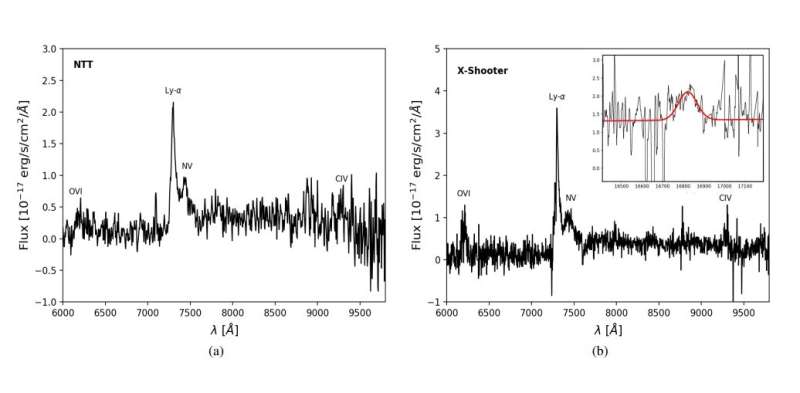September 2, 2019 report
New extremely X-ray-weak blazar discovered

Astronomers from Italy and Spain have detected a new blazar by analyzing data from two astronomical surveys. The newly found object, designated DESJ014132.4-542749.9, turns out to be an extremely X-ray-weak blazar at high redshift. The discovery is detailed in a paper published August 22 on arXiv.org.
Blazars, classified as members of a larger group of active galaxies that host active galactic nuclei (AGN), are the most numerous extragalactic gamma-ray sources. Their characteristic features are relativistic jets pointed almost exactly toward the Earth. In general, blazars are perceived by astronomers as high-energy engines serving as natural laboratories to study particle acceleration, relativistic plasma processes, magnetic field dynamics and black hole physics.
Some active galactic nuclei are strong radio sources, hence are called radio-loud (RL) AGNs. These objects are rare, especially at high redshift. Therefore, any new addition to the still relatively short list of RL AGNs is important for researchers aiming to advance our knowledge about active galaxies, quasars and blazars.
Now, a team of astronomers led by Silvia Belladitta of Brera Astronomical Observatory in Italy, reports the detection of DESJ014132.4-542749.9 (DES0141-54 for short) – a new powerful RL AGN at a redshift of 5.0. Its properties indicate that it is a blazar showcasing high radio loudness but weak X-ray emission. The finding is based on the analysis of data from the Dark Energy Survey (DES) and the Sidney University Molonglo Survey (SUMSS).
"In this work, we presented the discovery and the multiwavelength properties of DES0141-54, a very powerful RL AGN at high redshift (z = 5.0) when the universe was only 1.18 billion years old. This source was discovered by cross-matching the first data release of the DES with the SUMSS radio catalog," the astronomers wrote in the paper.
According to the study, DES0141-54 is the first radio-loud AGN at high redshift (over 4.5) discovered as part of the DES survey. The object exhibits very large radio loudness, high radio luminosity and flatness of the radio spectrum up to very high frequencies. These properties allowed the researchers to classify the newfound AGN as a blazar.
However, the astronomers found that DES0141-54, unlike the vast majority of known blazars, has an extremely weak X-ray emission. In particular, the blazar's X-ray luminosity is quite low compared to other high-redshift blazars discovered to date. Moreover, its X-ray-to-radio luminosity ratio is also small in comparison to low-redshift blazars.
Therefore, the astronomers concluded that DES0141-54 belongs to a minority (about 2 percent) of blazars with very weak X-ray emission.
"In particular, only two blazars (i.e.,about 2 percent of the total sample) have an XR [X-ray-to-radio luminosity ratio] similar to DES0141-54," the authors of the paper note.
Furthermore, the researchers speculate that the radio loudness and weak X-ray emission in DES0141-54 could be related to a particularly high value of the magnetic field. However, further studies of this blazar are needed to verify this scenario.
More information: S. Belladitta, et al. An extremely X—ray weak blazar at z=5. arXiv:1908.08552v1 [astro-ph.GA]: arxiv.org/abs/1908.08552
© 2019 Science X Network



















